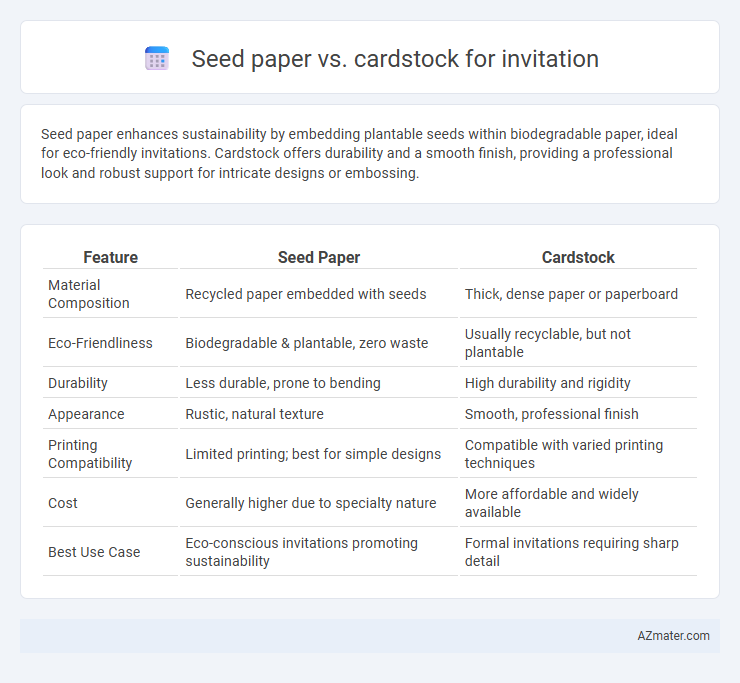Seed paper enhances sustainability by embedding plantable seeds within biodegradable paper, ideal for eco-friendly invitations. Cardstock offers durability and a smooth finish, providing a professional look and robust support for intricate designs or embossing.
Table of Comparison
| Feature | Seed Paper | Cardstock |
|---|---|---|
| Material Composition | Recycled paper embedded with seeds | Thick, dense paper or paperboard |
| Eco-Friendliness | Biodegradable & plantable, zero waste | Usually recyclable, but not plantable |
| Durability | Less durable, prone to bending | High durability and rigidity |
| Appearance | Rustic, natural texture | Smooth, professional finish |
| Printing Compatibility | Limited printing; best for simple designs | Compatible with varied printing techniques |
| Cost | Generally higher due to specialty nature | More affordable and widely available |
| Best Use Case | Eco-conscious invitations promoting sustainability | Formal invitations requiring sharp detail |
Introduction: Seed Paper vs Cardstock Invitations
Seed paper invitations offer an eco-friendly option, embedding biodegradable paper with seeds that blossom into plants when planted, perfect for environmentally conscious events. Cardstock invitations, made from thick, durable paper, provide a sturdy and elegant feel, ideal for formal occasions demanding a polished presentation. Choosing between seed paper and cardstock depends on the event's tone, sustainability goals, and desired tactile experience.
Environmental Impact: Sustainable Choices
Seed paper offers a sustainable choice for invitations by being biodegradable and embedded with wildflower seeds that promote plant growth after use, reducing waste and supporting biodiversity. Cardstock, while durable and professional, typically requires more resources to produce and is less eco-friendly due to its inability to decompose or contribute to environmental regeneration. Choosing seed paper over traditional cardstock significantly lowers the carbon footprint and supports a circular lifecycle in invitation materials.
Material Composition and Texture
Seed paper is composed of recycled fibers embedded with biodegradable seeds, providing an eco-friendly and textured surface that encourages planting after use. Cardstock, typically made from thicker, high-quality wood pulp or cotton fibers, offers a smooth, sturdy texture ideal for a polished, professional appearance. The choice between seed paper and cardstock depends on the desired tactile experience and environmental impact of the invitation.
Printing Compatibility and Quality
Seed paper offers a unique textured surface that may limit printing precision, often requiring specialized printers for optimal ink absorption and clarity. Cardstock provides a smooth, consistent finish compatible with most inkjet, laser, and offset printers, ensuring sharp, vibrant prints ideal for detailed invitation designs. Choosing cardstock enhances image quality and color accuracy, while seed paper emphasizes eco-friendly appeal with slightly reduced printing versatility.
Design Versatility and Customization
Seed paper offers eco-friendly design versatility with embedded wildflower seeds that enhance tactile and visual appeal, making invitations uniquely interactive and memorable. Cardstock provides superior customization options, supporting various textures, finishes, and weights that allow for precise printing techniques and intricate die-cut designs. Choosing between seed paper and cardstock depends on prioritizing sustainability and organic aesthetics versus premium customization and structural rigidity in invitations.
Durability and Handling
Seed paper offers biodegradable qualities but tends to be more delicate and prone to tearing compared to traditional cardstock, which provides superior durability and rigidity for invitations. Cardstock withstands frequent handling and transportation without bending or damage, making it ideal for events requiring sturdy and long-lasting invitations. The textured finish of seed paper can enhance tactile appeal but demands careful handling to preserve embedded seeds and overall integrity.
Cost Comparison: Seed Paper vs Cardstock
Seed paper invitations typically cost 30-50% more than standard cardstock options due to their eco-friendly materials and handmade production process. While cardstock is widely available and more budget-friendly, averaging $0.20 to $0.50 per sheet, seed paper ranges from $0.40 to $1.00 per sheet depending on seed variety and paper quality. The higher price of seed paper reflects its sustainability benefits and ability to be planted, making it a unique but costlier choice for invitations.
Guest Experience: Unboxing and After-Use Value
Seed paper invitations create a memorable unboxing experience by offering guests a tactile, eco-friendly touch that encourages sustainability and curiosity. Guests often appreciate the opportunity to plant the paper afterward, extending the invitation's value beyond the event itself. Cardstock invitations provide a sturdy, classic feel but lack the interactive and lasting environmental engagement that seed paper delivers.
Popular Uses and Event Types
Seed paper invitations are popular for eco-friendly weddings, garden parties, and environmental events, offering a unique touch that guests can plant to grow flowers or herbs. Cardstock invitations are widely used for formal events such as corporate gatherings, birthday parties, and upscale weddings due to their sturdy, high-quality feel and customizable finishes. Both materials cater to distinct event types, with seed paper emphasizing sustainability and celebration of nature, while cardstock focuses on durability and elegant presentation.
Final Recommendation: Which Invitation Material to Choose
Seed paper offers a unique eco-friendly option that sprout wildflowers when planted, ideal for nature-themed or sustainable weddings seeking memorable, biodegradable invitations. Cardstock provides durability, a smooth finish, and versatility in printing techniques, preferred for formal events requiring elegant, sturdy designs. Choose seed paper for environmental impact and novelty, while cardstock suits traditional aesthetics and lasting keepsakes.

Infographic: Seed paper vs Cardstock for Invitation
 azmater.com
azmater.com